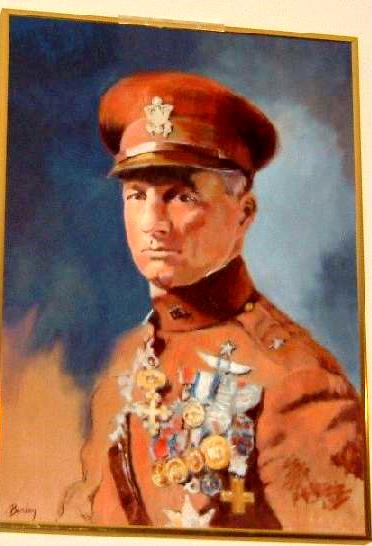General Billy Mitchell Biography

General Billy Mitchell Post 85 is named for General Billy Mitchell, the man considerd to be the father of military aviation.
William Lendrum "Billy" Mitchell (December 28, 1879 – February 19, 1936) was
a
United States Army
general who is regarded as the father of the
U.S. Air Force. He
is one of the most famous and most controversial figures in the history of
American airpower.
Billy Mitchell's name conjures up different and
mostly stereotyped images. For those with an interest in airpower, it brings
to mind the visionary who sank battleships and paid the price for defying
the War Department. Unfortunately, for far too many, the name Billy Mitchell
is associated only with a grainy black-and-white movie showing Gary Cooper
fighting a court-martial.
Brig. Gen. William L. Mitchell deserves better than
this. So great was his impact on the Army Air Service and its successor
organizations that the effect is still being felt. During Mitchell's
meteoric military career, he charted new paths, set new standards, and
influenced key leaders for decades to come. Mitchell was twenty years ahead
of his time when he put forth his detailed vision of a hazardous future.
More important, he knew that airpower was the answer to overcoming the
danger. His impassioned campaign to tell his story had a quadruple-barreled
impact on the modern Air Force, past, present, and future.
Billy
Mitchell was born into privileged circumstances in Nice, France, on December
29, 1879. His father, John L. Mitchell, became a US senator and would
quietly smooth the way for his impetuous son's early military career.
Billy Mitchell graduated from Columbian College of
George Washington University, where he was a member of the DC Alpha chapter
of the Phi Kappa Psi Fraternity. He then enlisted as a private at age 18
during the Spanish American War. Quickly gaining a commission due to his
father's influence, he joined the U.S. Army Signal Corps. Following the
cessation of hostilities, Mitchell remained in the army.
He predicted as early as 1906, while an instructor at
the Army's Signal School in Fort Leavenworth, Kansas, that future conflicts
would take place in the air, not on the ground.
Billy Mitchell immediately got on the fast track by demonstrating his
leadership and organizational skills in the Philippines and Alaska. Without
a contracting officer's warrant, he managed to spend $50,000 of US
government money to build a telegraph line across Alaska--on an authorized
budget of $5,000. The overrun must not have hurt Mitchell; he came back a
captain at age twenty-three, the youngest in the Army.
At
thirty-two, Mitchell became the youngest officer ever appointed to the Army
General Staff. While in Washington, he felt the first attraction to
aviation, seeing in it the future for his country and, not incidentally, for
himself. In 1908, when a young Signal Corps
officer, Mitchell observed Orville Wright's flying demonstration at Fort
Myer, Virginia.Paying for his own flying lessons,
he learned to fly in four Sunday sessions at the Curtiss Flying School,
Newport News, Va., in 1915.
Mitchell's flying catapulted him to prominence, and
he became deputy chief of the Signal Corps Aviation Section in 1916, with
the rank of major. This was his ticket to the top. He wangled his way to
France as a military observer in March 1917. When the US declared war on
Imperial Germany the next month, he soon established himself as the premier
US aviation officer in France. He was promoted to lieutenant colonel in May
and to colonel in August 1917 and received a rating as a Junior Military
Aviator without the normal testing process.
Fluent in French, unlike most of his colleagues,
Billy Mitchell became a master networker-cementing ties, obtaining
resources, making friends, and pledging help.
Mitchell commanded 1,476 aircraft and twenty
balloons, assembled from 101 American, British, French, and Italian
squadrons, in the greatest air offensive of the war, the battle of
Saint-Mihiel.
By the conflict's end, Mitchell commanded all
American air combat units in that country. Recognized as one of the top
American combat airmen of the war alongside aces such as Eddie Rickenbacker,
he was probably the best-known American in Europe. He was awarded the
Distinguished Service Cross, the Distinguished Service Medal, the World War
I Victory Medal with eight campaign clasps, and several foreign decorations.
Despite his superb leadership and his fine combat record, he alienated many
of his superiors during and after his 18 months in France.
After
the war, he was appointed deputy director of the Air Service and began
advocating increased investment in air power, believing that this would
prove vital in future wars. He argued particularly for the ability of
bombers to sink battleships and
organized a series of bombing runs against stationary ships designed to test
the idea.
In 1924, Mitchell was dispatched on an inspection
tour to Hawaii and Asia. He came back with a 324-page report that predicted
future war with Japan, including the attack on Pearl Harbor.
He antagonized many people in the Army with his
arguments and criticism and, in March 1925, when his term as Assistant Chief
of the Air Service expired, he reverted to his permanent rank of Colonel and
was transferred to San Antonio, Texas, as air officer to a ground forces
corps.
Later that year, he was court-martialed for
insubordination after accusing Army and Navy leaders of an "almost
treasonable administration of the national defense." He resigned from the
service shortly afterward.
In 1926, Mitchell made his home with his wife
Elizabeth at the 120-acre (0.49 km2) Boxwood Farm in Middleburg,
Virginia which remained his primary residence until his death in 1936
Mitchell received many
honors following his death, including a commission by President Franklin
Roosevelt as a
Major General. He is also the only
individual after whom a type of American military aircraft, the B-25
Mitchell, is named.